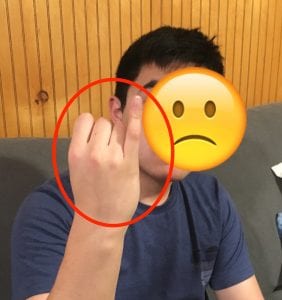General Information about Item
- Gesture
- Genre: Insulting American Children’s Gesture
- Country of Origin: United States
- Informant: Alejandro Cuan-Martinez
- Date Collected: October 28, 2018
Informant Data
Alejandro is a ’20 that attends Dartmouth College. He is from Los Angelas, California where he grew up for most of his childhood. He is of Chinese-Mexican decent and has an older brother. In high school he was on the swim team. He is interested in studio arts and is a member of the Alpha Theta gender-inclusive greek house.
Contextual Data
Social Context – I collected this folklore from Alejandro in Alpha Theta’s library. I recorded our conversation on an iPhone and asked him to tell me about insulting gestures he may remember from childhood. It was humorous the wide array of gestures he recalled from childhood that he would use to insult his friends in primary school. Many of the gestures were subtle variations of the middle finger, used in a manner to get away with giving someone the bird without actually doing the gesture but fully implying it with a similar one. Most of the gestures he showed me were ones targeted towards a specific person with the intention of being seen and received, with the ability to be quickly concealed if an adult was to look.
Cultural Context – Alejandro learned flipping off with his ring finger in middle school. The actual middle finger was for when you’re older so in middle school, the ring finger was the next closest thing.
Item
“It’s the same thing as a pinky – you make your hand into a fist and then raise your ring finger. People think it looks like you’re flipping someone off and using your middle finger, but really it’s your ring finger.”
Associated Image
Informant’s Comments
Alejandro found it particularly funny when mentioning that the middle finger is for when you’re older. When I inquired why, he mentioned that it felt more like you were fully committing to insulting someone and it was like swearing for the first time when you did actually flip someone off.
Collector’s Comments
I remember my own friend getting mad one day and accidentally flipping the bird and when he was confronted about it, he immediately denied it and said he was raising his ring finger, not his middle finger. For some reason, changing that one thing made it less rude and a bit more acceptable, as he got off with only a slap on the wrist.
Collector’s Name: Cherie-Noelle Kaanana
Tags/Keywords
- Gestures
- American Children
- Insults




